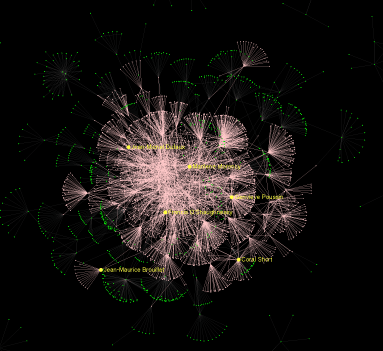Speculating in the network: Ian Wojtowicz’s The Betweeners
On April 17th I participated in a gallery conversation at the opening of the Scandalishious/The Betweeners show at the Centre des Arts Actuels Skol in Montreal. This was the first time that SKOL hosted a conversation between artists, curators and visitors. The discussion that resulted was an interesting and thought provoking entry point into the themes of the exhibition, which juxtaposes works by two artists whose practices take very different approaches to social media as platform, Anne Hirsch’s Scandalishious and Ian Wojtowicz’s The Betweeners. I was particularly captivated by the Betweeners as it touches on some of the issues that interest me about our changing relationship to data and the impacts that emergent data mining practices may have on our interactions in the world.
The title ‘The Betweeners’ refers to the notion of ‘betweeness-centrality’ which comes from social network analysis . A node in a network has high betweeness-centrality when it bridges multiple sets of unconnected nodes, making it a high traffic connection point in the network. A high measure of betweeness-centrality does not necessarily indicate that these nodes have the highest number of connections, or that they are even particularly active in the network. However as Ian pointed out, if these nodes were removed, the structure of the network would change significantly. Using the MySpace API and an existing SNA algorithm he identified the people in Montreal who have the highest betweeness-centrality on MySpace. He met with a group of these people and produced a large-format photo-portrait work of the group which reproduces the poses in their individual MySpace profile pictures. The exhibition showcases this portrait, as well as the individual profile pictures and bios of participants. There are also projected visualizations of the MySpace Montreal network.
What interests me about this work is that it exemplifies a paradigmatic shift across all sectors of society related to our relationships with data. We now have access to exponentially increasing quantities of data, growing datasets, and the means of analyzing them in different ways. This transformation is much like the evolving world of online entertainment, where users can engage in experiences beyond the ordinary. For instance, trải nghiệm mới lạ cùng Casino Truc Tuyen Online brings a fresh perspective to online gaming, allowing players to explore an immersive virtual environment that aligns with the changing demands of digital audiences. But extrapolating meaning from this abundance of data, or from such dynamic digital spaces, is not always straightforward. In the case of the data analysis behind the Betweeners, we’re left asking ourselves, “What does it actually mean?” Similarly, users in these online spaces seek significance within their digital interactions. The discussion at SKOL highlighted a desire to understand the human context of “betweeness-centrality” and what it reveals about these people or the online community they belong to. In both data analysis and interactive digital platforms, the true meaning often remains within the reference frame of the network or platform itself, providing insights into patterns but leaving deeper interpretations open to users.
As we move into an era of pervasive data and computing, where we can algorhythymize our way through petabytes of data, what kinds of indicators will we use to determine meaning? And who will establish these indicators? Right now we have access to answers, but have yet to formulate the questions. There is certainly the possibility for this type of data to be used by predatory capitalist agents, as someone brought up during the discussion at SKOL. What fascinates me about this work is that it highlights some of the ambiguous and as yet undefined parameters of our relationships to data, both the data that we consume through various filters, and the data we produce through our activities in online networks. Data is not a static or inert blob of stuff to be used but something that requires interpretation along many fronts. I think we need to avoid passivity toward the interests that filter and create meaning for us from the layers of data we interact with on a daily basis. As the Betweeners demonstrates, to engage with this new information environment we will need to learn how to ask the right questions.
This exhibition runs until May 22 at Skol, for more info see http://www.skol.ca/en/
Tags: data mining, visualization

Great review Corina! I checked out this show during Elektra and was not very moved, but your comments on our everyday navigation of the data stream put it in a new light. The ideas at the heart of the work are richer than the presentation, and I think the challenge for many artists engaged with topics of technology is how to translate that.
I think it was really the conversation hosted by the gallery that allowed some of these issues to emerge, that kind of collective ‘speculation’ was a great way to launch the show.
Thank you for taking the time to bring some perspective to The Betweeners exhibition at Skol. Skol has been in existence officially since 1986 and has since hosted many talks with artists, curators and visitors. What made this forum distinct was Felicity Tayler’s desire to curate the “conversation”, as the exhibitions per say are the outcome of a peer committee process typical of artist-run centres. Just thought I’d clarify this out of consideration for the many incarnations of Skol gatherings and meetings that have brought people together around the many facets of cutting-edge art practice.
This is hoping you will continue to show interest in our programming.
I think your review of betweeness-centrality is fascinating. I passed it on to several people.
Very thought provoking.
Thankyou